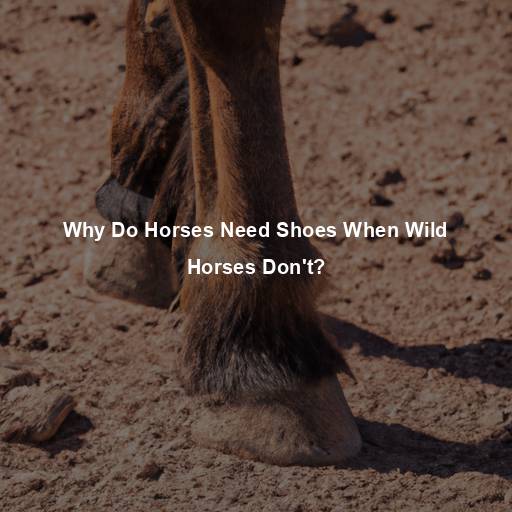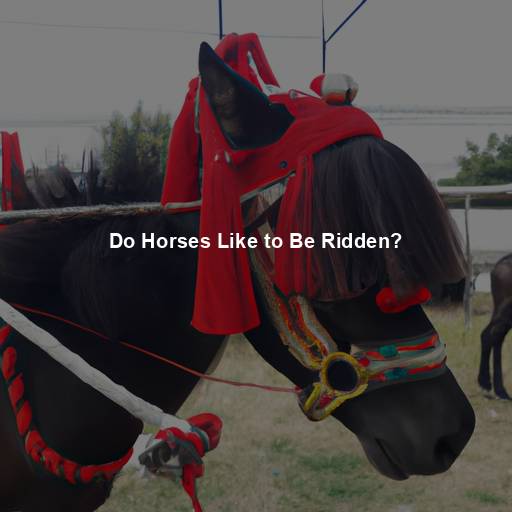Why Do Horses Need Shoes When Wild Horses Don’t?
Last Updated on November 7, 2023 by Evan
Contents [hide]
- 1 Understanding the Purpose of Horseshoes
- 2 The Impact of Domestication
- 3 The Role of Horseshoes
- 4 The Importance of Regular Hoof Maintenance
- 5 Natural Alternatives to Traditional Horseshoes
- 6 The Ongoing Debate
- 7 Caring for Your Horse’s Hooves
- 8 FAQs: Why do horses need shoes when wild horses don’t?
- 8.1 Why do domesticated horses need shoes?
- 8.2 Do all domesticated horses need shoes?
- 8.3 Don’t wild horses manage fine without shoes?
- 8.4 Can domesticated horses be barefoot like wild horses?
- 8.5 How often do horses need their shoes replaced?
- 8.6 Do horseshoes hurt the horse?
- 8.7 Can horses go without shoes in all climates?
Understanding the Purpose of Horseshoes
For centuries, the enigmatic relationship between horses and horseshoes has captivated the minds of the curious. Why do these majestic creatures, tamed and domesticated, necessitate the protective embrace of metal footwear? And yet, their untamed brethren roam freely, seemingly undisturbed by the constraints of a horseshoe. To unravel this enigma, we must embark on a journey into the captivating realm of horses, unearthing the intricate reasons that compel the need for these equine adornments.
The Evolutionary Advantage of Wild Horses
It’s truly fascinating how horses, in their untamed state, have undergone such an incredible evolutionary journey. Over countless centuries, they have developed an innate ability to seamlessly acclimate to their surroundings. Their remarkable hooves, with their durability and adaptability, serve as a testament to their tenacity in navigating diverse terrains. These awe-inspiring creatures roam freely, covering expansive distances, as they fortify their hooves through unrelenting motion.
The Impact of Domestication
When we consider the impact of domestication on horses, the narrative takes an intriguing turn. Through deliberate breeding, domesticated horses have been tailored to suit particular needs like racing, labor, or recreational riding. However, this adaptation comes with its own set of enigmatic complexities. Confined to a more regulated setting, these horses confront challenges to their hoof health stemming from restricted mobility, limited natural surfaces, and an environment that deviates from their inherent characteristics.
Changes in Hoof Health
It’s no secret that our equine companions, those majestic domesticated horses, often find themselves confined within the walls of stables or enclosures. However, this seemingly innocuous lifestyle can have some unforeseen consequences for our beloved four-legged friends. With limited opportunities for natural wear and tear on their hooves, horses may find themselves confronted with weakened defenses against the perils of their daily walks. The unforgiving surfaces beneath their feet, whether unforgiving concrete or abrasive gravel, can spell trouble for their precious hooves, leaving them vulnerable to potential damage and injury.
The Role of Horseshoes
Crafted with precision and expertise, horseshoes have evolved into a versatile range of materials – from the resilient steel to the lightweight aluminum and even the innovative synthetic compounds. These hoof guardians, thoughtfully fitted and expertly applied by skilled farriers, bestow a myriad of advantages upon our majestic equine companions. From shielding delicate hooves to providing vital support, these horseshoes are a testament to the intricate relationship between craftsmanship and the well-being of our beloved horses.
Protection from Wear and Tear
When it comes to the well-being of our equine friends, horseshoes play a pivotal role as the unsung heroes of hoof care. These humble metal protectors act as a formidable barrier between the tender hooves and the unforgiving ground. By doing so, they safeguard against the relentless wear and tear, sparing our noble companions from potential hoof damage and the unbearable pain it brings. In essence, horseshoes are like trusty shields, warding off the harshness of hard and abrasive surfaces, allowing the hooves to flourish in strength and health.
Enhanced Traction and Stability
When it comes to the equine world, one cannot overlook the remarkable impact that horseshoes have on a horse’s stride. These metal marvels not only enhance a horse’s grip on treacherous terrain but also bestow unparalleled stability on these majestic creatures. From the racing tracks to the jumping arenas and even the weight-bearing tasks, horseshoes play a pivotal role in safeguarding our four-legged friends from the perils of slips, falls, and the dreaded specter of injuries. Their importance is as undeniable as it is perplexing.
Corrective and Therapeutic Purposes
When it comes to our equine companions, hoof health is of paramount importance. In certain situations, the majestic beauties we know as horses may benefit from the expertise of specialized horseshoes. Crafted with precision and purpose, these unique shoes cater to specific hoof conditions or injuries, offering a glimmer of hope in the healing journey. Whether it’s combating the notorious laminitis, tackling the daunting navicular syndrome, or rectifying imbalances in hoof structure, therapeutic horseshoes prove to be a perplexing yet promising solution.
Compensation for Domestication
When it comes to the hoof health of our domesticated equine companions, it’s worth delving into the perplexing effects of their domestication. As our earlier discussion alluded, the use of horseshoes adds an element of burstiness into the equation. While this artificial extension might seem contrary to the notion of preservation, it actually compensates for the dearth of natural wear and tear that accompanies life outside the confines of domesticity. Horseshoes, in their own enigmatic way, emulate the advantages that their wild counterparts inherently possess.
The Importance of Regular Hoof Maintenance
When it comes to hoof health, we can’t simply rely on horseshoes as a magical fix. To keep those hooves in top shape, it’s imperative to prioritize regular maintenance. This includes trimming and cleaning to keep things tidy. Oh, and don’t forget about those farrier visits – they’re like the superheroes of foot care, making sure the shoes fit just right and assessing the overall condition.
Assessing Hoof Condition
When a farrier arrives to shoe a horse, they begin by assessing the condition of the hooves. They look for any signs of damage, cracks, or imbalances that may need attention. This careful examination allows them to determine the appropriate type and size of horseshoes required.
Choosing the Right Shoes
There is no one-size-fits-all approach when it comes to horseshoes. Farriers consider various factors, including the horse’s breed, size, activity level, and hoof condition when selecting the appropriate shoes. They take into account the horse’s individual needs to ensure a proper fit and optimal support.
Customizing the Fit
When it comes to equine footwear, the farrier’s craftsmanship takes center stage in a symphony of adaptation and precision. The journey begins with the judicious selection of horseshoes, followed by a transformative process that seems like alchemy. These coveted pieces are subjected to the dance of heat, rendering them pliant and receptive to manipulation. The farrier skillfully bends and molds them to harmonize with the unique contours of the horse’s hooves, creating a symphony of comfort and stability that leaves no hoof unturned.
Nailing the Shoes
Crafting horseshoes is a true art form; once they’ve been delicately shaped, the skilled farrier carefully adorns the hooves, nailing them with utmost precision. It’s a dance of finesse, ensuring the horse’s comfort and safety throughout the process. Each nail delicately pierces the hoof wall, securing the shoes with gentle grace, leaving no room for discomfort or harm.
Trimming and Balancing
In addition to shoeing, farriers are responsible for trimming and balancing the hooves. They carefully remove excess growth and maintain the proper hoof length. This helps to prevent imbalances and ensures that the weight is distributed evenly across the hooves, promoting healthy movement.
Regular Maintenance
Keeping your horseshoes in top shape is crucial for their performance, but it can be quite the perplexing task. Whether your trusty farrier suggests a shoeing appointment every four to six weeks or not, the burstiness of your horse’s needs will determine their maintenance schedule. Rest assured, during these appointments, your skillful farrier will unveil an intricate dance of assessing shoe conditions, trimming hooves if needed, and meticulously making adjustments to guarantee optimal comfort and unwavering support.
Natural Alternatives to Traditional Horseshoes
In the realm of equine footwear, the tried and true horseshoe has long held its ground. However, a captivating wave of curiosity has surged among horse owners, sparking an exploration of more natural alternatives. In a quest to strike a harmonious balance between hoof health and functionality, a myriad of intriguing options have emerged, captivating the equestrian world. Join us on this journey as we unravel the enigmatic realm of hoof care, where tradition meets innovation.
Barefoot Trimming
Barefoot trimming involves carefully trimming the hooves to mimic the natural wear and shape that wild horses experience. This method aims to promote hoof health and strength through proper alignment and balance. Advocates of barefoot trimming argue that it allows the hooves to function naturally, improving circulation and shock absorption.
Hoof Boots
Hoof boots offer a temporary and removable alternative to traditional horseshoes. These boots are designed to provide protection and support while allowing the hooves to function more naturally. Hoof boots can be beneficial for horses that require occasional extra support during specific activities, such as trail riding or competitions.
Glue-On Shoes
Step into a world where traditional horseshoes take a backseat and glue-on shoes step into the spotlight. Bid farewell to the days of clunky nails and welcome the era of adhesives seamlessly bonding shoes to hooves. Embrace this perplexingly innovative solution that not only minimizes discomfort and hoof damage but also grants hooves the freedom to move more naturally. Lace up your curiosity and navigate the fascinating realm of glue-on shoes for an equestrian experience like no other.
The Ongoing Debate
Horseshoes: A Controversial Conundrum Unveiled
The enduringly heated discussion surrounding the indispensability of horseshoes has ignited a fiery debate within the inner circles of equestrian aficionados and experts alike. Curiously, as both sides passionately push their arguments to the forefront, the question lingers in the air, like a captivating mystery waiting to be unraveled. Advocates of barefoot equine living assert that, under ideal circumstances and meticulous hoof preservation, our four-legged companions can flourish sans shoes, fostering hoof vitality and heightening their overall flourishing existence. The enigma persists, captivating the equine community, as the best course of action gains an air of bewilderment and perplexity.
The debate surrounding the use of horseshoes has sparked intriguing arguments from both sides. While some champion the advantages of traditional horseshoes in terms of safeguarding, boosting performance, and providing crucial support, others argue for more holistic approaches to horse care. This perplexing clash of opinions leaves us pondering the best course of action for equines engaged in strenuous activities or those with specific hoof conditions that demand specialized attention.
Ultimately, the choice between using horseshoes or exploring natural alternatives depends on various factors, including the horse’s individual needs, activity level, and hoof health. It is crucial to consult with a knowledgeable farrier and consider all options before making a decision.
Caring for Your Horse’s Hooves
Regardless of whether your horse wears shoes or goes barefoot, proper hoof care is of utmost importance. Here are some essential tips to help maintain your horse’s hoof health:
Regular Cleaning and Inspection
Regularly clean your horse’s hooves with a hoof pick to remove debris and check for any signs of injury or infection. Look out for cracks, thrush (a bacterial infection), or any abnormalities that may require attention.
Balanced Diet and Nutrition
When it comes to hoof health, there’s no horsing around. A diet that packs a punch in all the right nutrients is the secret to keeping those hooves in top-notch shape. From biotin to zinc, these minerals are the true hoof heroes, so make sure your trusty steed gets its fair share. For expert advice tailored to your horse’s needs, consult with a knowledgeable veterinarian or equine nutritionist who can help you navigate the perplexing world of hoof nutrition.
Consistent Exercise and Movement
Ensuring your equine companion remains active is an absolute game-changer when it comes to the health and happiness of those magnificent hooves. Carve out generous pockets of time for them to roam and dabble in the art of unrestricted movement. It’s like giving their little trotters a spa day, boosting blood flow and reigniting the secret code for flourishing hoof growth.
Regular Farrier Visits
Ensuring the well-being of your noble equine companion requires embracing the enigmatic world of hoof care. Summon the expertise of a seasoned farrier regularly to unravel the intricate mysteries of your stallion’s hooves. Through meticulous trimming and, if fate demands, the fitting of custom-made shoes, you shall navigate the labyrinth of equilibrium, nurturing optimal hoof growth and quelling any cryptic concerns that may emerge.
Monitor Hoof Moisture
Maintaining the perfect balance of moisture is essential for the health of hooves, as too much or too little can lead to detrimental effects. It is crucial to steer clear of excessively damp or arid conditions, as they can perplex hoof well-being. Seeking guidance from a knowledgeable farrier can provide valuable insights into selecting the right hoof moisturizers or dressings, should the need arise.
When it comes to the well-being of your beloved horse, taking care of their hooves should not be taken for granted. By embracing these invaluable suggestions, alongside collaborating with your trusted veterinarian and farrier, you will unveil the secret to maintaining a state of hoof healthiness. Regardless of whether your majestic equine friend prefers the fashionable comfort of shoes or the exhilarating freedom of going barefoot, rest assured that a well-informed approach will lead you down the path of certainty and assurance. Embrace the power of knowledge and be a proud advocate for your horse’s hoof health!
FAQs: Why do horses need shoes when wild horses don’t?
Why do domesticated horses need shoes?
Throughout the centuries, the remarkable evolution of domesticated horses has led to a myriad of specialized breeds catering to the diverse needs of humans. These majestic creatures, selectively bred for purposes ranging from equestrian sports to labor-intensive tasks, find themselves confronted with unfamiliar challenges in their human-made environments. As their hooves and legs bear the weight of responsibilities like racing or hauling, the strains placed upon them are not to be underestimated. However, enter the humble shoe, a revolutionary solution designed to fortify these remarkable creatures by mitigating the risks posed by alien terrains and intensifying their prowess in the face of demanding endeavors.
Do all domesticated horses need shoes?
The question of whether or not our beloved domestic horses require shoes is as complex and multifaceted as the creatures themselves. There is no one-size-fits-all answer, as the need for shoes depends on a myriad of intricate factors. It all boils down to the individual horse, their unique needs, and the environment that surrounds them. From soft pastures to challenging terrains, considerations must be taken into account before coming to a definite conclusion. Seeking guidance from a trusted veterinarian or farrier is paramount to ensuring the optimal well-being of our equine companions.
Don’t wild horses manage fine without shoes?
Yes, wild horses have evolved over thousands of years to adapt to their natural surroundings. They have developed strong hooves that are naturally more durable and self-maintaining. Wild horses generally live on varied terrains, spending most of their time on soft, natural surfaces like grassy meadows or sandy ground. Continuous movement, natural wear, and proper herd dynamics help keep their hooves in good condition without the need for shoes.
Can domesticated horses be barefoot like wild horses?
There is an intriguing phenomenon in the realm of domesticated horses, one that embraces the unexpected and challenges conventional wisdom. It appears that some of these majestic creatures can defy common expectations and wander barefoot through life, if their hooves possess the fortitude and vitality necessary to brave such a peculiar existence. Of course, this unconventional lifestyle is not without its conditions; horses must be spared the relentless toil of traversing treacherous surfaces in order to embark upon this daring adventure. The transition from the conventional hoof and shoe alliance to the minimalist path of barefoot liberation demands a delicate dance of conditioning and vigilant monitoring of hoof health. As this audacious experiment unfolds, a gradual adaptation period ensues, allowing the horse’s hooves to acclimate to this newfound audacity. However, it is imperative to acknowledge that every horse possesses a distinctive essence, and thus, consulting with a discerning farrier or veterinarian becomes an essential rite of passage to determine if this particular steed possesses the mettle to embrace a shoeless existence. Through the lens of equestrian wonder, one can’t help but marvel at the mysteries and idiosyncrasies that grace the equine universe.
How often do horses need their shoes replaced?
The eternal dance of horse and hoof spins a web of unpredictable decisions, where factors intertwine like the strands of destiny. From the wild gallops on rugged terrains to the dainty steps of a serene meadow, the frequency of shoe replacement hardly succumbs to a linear equation. A waltz of diversity, some noble steeds gracefully demand new shoes every six to eight weeks, their hooves craving the embrace of support and protection. Others, guided by an enigmatic blueprint, tread a path less traveled, their individual needs dictating a different rhythm altogether. Yet, amid this perplexing symphony, one truth remains: hoof maintenance, a timeless ritual of trimming, must never be forsaken, for even the shoeless equine cherishes a groomed path towards grandeur.
Do horseshoes hurt the horse?
When it comes to the delicate dance of horseshoes and hooves, skilled farriers have a crucial role to play in keeping our majestic equine friends comfortable. With an astute eye for detail, these experts consider every nuance – the horse’s unique conformation, the shape of its hooves, and any special requirements it may have – all with the singular aim of achieving a precise fit. However, in this delicate ballet, if the shoes are fitted incorrectly or the farrier’s workmanship falls short, the consequences can be discomfort and potential harm. To safeguard our beloved horses, it is imperative to entrust their hoof care to competent and respected farriers.
Can horses go without shoes in all climates?
There is a fascinating paradox when it comes to horses and their footwear preferences. While it is commonly believed that some horses can thrive without shoes in various climates, the truth is far more intricate and perplexing. The ever-changing environmental conditions can throw a curveball into these equine fashion choices. It is especially challenging for horses residing in treacherously rocky or icy terrains, where wearing shoes becomes a necessity for optimum traction and safeguarding. Moreover, horses inhabiting the damp and muggy corners of the world face a higher probability of encountering hoof predicaments. The intrusion of excessive moisture can lead to a softening conundrum that compromises the steadfastness of going barefoot. In light of this complex conundrum, making a well-informed choice between horseshoes and bare hooves necessitates careful analysis of individual circumstances and the thoughtful advice of proficient veterinarians and farriers.







